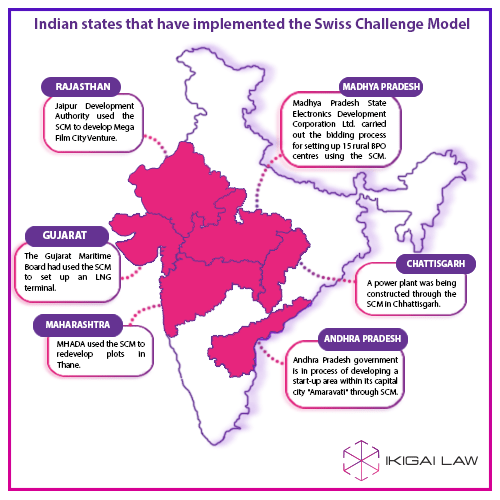1. Preliminary
Viability gap funding, least cost method, annuity models are various methods of public procurement that are used by governments for the development and/or maintenance of infrastructure projects. In most cases of public procurement projects, the government is required to pre-design the project and determine the contours of the implementation model. However, in certain cases the government may not have the requisite expertise. In such cases, the government may use the Swiss Challenge Model (“SCM”), which provides an alternative procurement method, to allow private developers to make unsolicited projects proposals to the government. SCM provides an impetus to private developers to identify new and unique infrastructure projects bases on innovative technology and methodologies. This piece provides an overview of the SCM, explores the manner in which SCM is used in India, and the advantages and challenges associated with this model.
2. What is the Swiss Challenge Model?
Simply put, the SCM is a private sector-initiated procurement method, where a private developer makes an unsolicited public infrastructure project proposal to the government[1]. Once approved, the government then seeks counter proposals against the original proposal and chooses the best amongst all options (including the original project proposal). Though there is no authoritative source of information, it is opined that this model is named “Swiss Challenge Model”, perhaps since “neutrality” was the central piece of Swiss national policy during the two world wars and the model relies on neutrality or the absence of bias between the project proponent (the original project proposer) and the challenging bidders (the counter project proposers)[2]. A prominent example is the recent development of the hyperloop in Maharashtra: a transport system that can ferry people and cargo at very high speeds in sealed tubes[3]. In this case, Virgin Hyperloop One had approached the Maharashtra government with an unsolicited proposal to construct the world’s first commercially operable Hyperloop and the Maharashtra government was able to entertain such a proposal by employing the SCM (Read our post on the project here).
3. How does the Swiss Challenge Model work?
Typically, in a SCM a developer makes an unsolicited proposal to a government for the development and/or maintenance of an infrastructure project. The government may accept the project proposal, and declare the proposing entity the ‘project proponent’. Based on the details of the project proposal and any modifications made by the government to suit the needs of the proposed project, the government may then invite third party bidders seeking better alternatives to the project proponent’s proposal. The government then compares the challenging proposals against the project proponent’s proposal to determine if any of them provide a better alternative (based on an evaluation of various factors such as innovativeness, efficient utilisation of resources, financial feasibility, quality of components, timelines, technology). The project proponent in most cases is granted the “right to first refusal”. If the project proponent agrees to match its offer to the challenging proposal, the project is awarded to the project proponent, else it is awarded to the challenging bidder. If it is awarded to the challenging bidder, the project proponent is compensated for the costs incurred for its expenses by the government.

4. Is the Swiss Challenge Model commonly used?
SCM is considered a viable mode of public procurement and has been used with varying levels of success in many countries including India, South Korea, Philippines, Chile, Argentina, Indonesia, South Africa, Sri Lanka, Bangladesh and Taiwan. Several Indian states such as Andhra Pradesh, Rajasthan, Karnataka, Madhya Pradesh, Chhattisgarh, Gujarat, Maharashtra, Punjab and Bihar have allowed SCM to be used for public-private partnership projects[4],[5]. For example, the Jaipur Development Authority[6] had used the SCM to develop Mega Film City Venture[7], the Indian Railways[8] had employed the SCM to redevelop 400 stations[9], and the Maharashtra Housing and Area Development Authority[10] (“MHADA”) had used SCM for a housing project in Thane[11]. The Reserve Bank of India in September 2016 had also approved the use of SCM for the sale of stressed assets by banks[12]. The use of this method was suggested by the RBI to lower the quantity of non-performing assets sold by banks and enable fasted debt aggregation by securitisation and reconstruction companies[13].
5. What does the Supreme Court of India say about the Swiss Challenge Model?
The Supreme Court of India has held the SCM as a viable mode of private public procurement for infrastructure projects in the case of Ravi Development v. Shree Krishna Prathisthan and Others[14]. In this case, Ravi Development had made an unsolicited proposal to MHADA to develop plots of land in Thane, Maharashtra. MHADA had decided to employ the SCM on a pilot basis for this project. MHADA had informed all participating bidders that the project would be awarded to the highest bidder only if the original proposer (Ravi Development) could not match the challenging bid or turned down the project thereby granting Ravi Development the right to first refusal. After the project was awarded to Ravi Development by MHADA, other bidders filed a writ petition against MHADA over its decision in the Bombay High Court stating that the procurement process was unfair. The Bombay High Court struck down the award granted by MHADA. This decision was appealed before the Supreme Court by Ravi Development. The Supreme Court ruled in favour of the appellant and held that the SCM process followed by MHADA was fair and transparent. Specifically, on the issue of implementation of SCM, the court observed that the State governments should look at the following issues[15]:
- State/authority shall publish in advance the nature of SCM and particulars in relation thereof;
- Publish the nature of projects that can come under such method;
- Mention/notify the authorities to be approached with respect to the project plans;
- Mention/notify the various fields of the projects that can be considered under the method;
- Set rules regarding time limits on the approval of the project and respective bidding;
- The rules are to be followed after a project has been approved by the respective authorities to be considered under the method; and
- Incorporate any other clauses for transparency and proper execution of SCM.
The court also observed that the state governments should also frame “regulations/instructions on the above lines”[16]. This judgement is an important milestone for it provides legitimacy to SCM by the apex court of the country. It also provides an opportunity to the state governments to provide a policy and regulatory framework to implement SCM in a standardized manner.
6. What are the advantages of the Swiss Challenge Model?
6.1 Innovative solutions:
SCM has gained prominence because it allows governments to spot unidentified infrastructural needs and pool innovative solutions to address the society’s needs. For example, in Jafrabad, Gujarat, the Gujarat Maritime Board[17] was able to construct a low-cost and efficient Liquefied Natural Gas terminal with a floating storage and re-gasification unit by employing the SCM[18]. Elsewhere, the Columbian government[19] had used the SCM to speed up the implementation of priority highway projects which otherwise would have taken a considerably longer time[20]. Chile too was able to implement more projects in lesser time compared to its previous situation where it used common procurement methods[21].
6.2 Development of technically advanced projects and building state capacity:
The private sector generally propels innovation in technology by investing in research & development. Many of these private sector led technological developments tend to have the potential to address large scale public infrastructure needs. The SCM acts as a bridge between the government and the private sector, hence enabling both parties to collaborate and experiment with these new technologies. For instance, the Mumbai-Pune Hyperloop project[22], that was awarded using the SCM, will allow the Maharashtra government to undertake a project that has not been implemented anywhere else in the world[23]. It will enable the Maharashtra government to develop novel regulatory mechanisms to regulate untested and hybrid transportation – an ability that most governments would lack – and become capable enough to undertake such projects in the future. SCM also allows for greater private sector participation and can be further used extensively to undertake projects at the local level based on the expertise of private parties specific to such local infrastructure requirements.
7. What are the key challenges of the Swiss Challenge Model?
Although the SCM allows governments to implement innovative infrastructure projects, the model has received a fair amount of criticism[24]. The most obvious risk is the SCM led public procurement may lead to less than fair and transparent bidding process[25]. It is argued that the original project proponents have a ‘time’ advantage compared to challenging proponents since the former has no time-based restrictions to create an ideal project proposal whereas the later have to present their counter proposals within a certain timeframe[26]. It is also difficult to measure the appropriate monetary compensation for the unsolicited project to the original proponent when the project is awarded to another challenging bidder[27]. Some projects may also stall due to the limited technical acumen of the governments. Such a hurdle was faced by the Gujarat Maritime Board when it found it difficult to assess the technical feasibility of SWAN Energy Limited’s technology[28]. The legal validity of the SCM may be challenged when counter proposals contain different specifications compared to the specification of the original proposal[29].
8. What is the conclusion?
Though the SCM provides itself as a good alternative to traditional project procurement methods, it is yet to gain enough traction and become mainstream. The SCM’s use for project procurement, however, appears to be increasing. Many governments have now started to experiment with the SCM owing to its benefits and hence it is likely that SCM may become mainstream in procuring projects in the future. The adoption of SCM may further increase if set bidding guidelines for SCM are framed after wide consultation. As observed by the Supreme Court in the Ravi Development case, it will be imperative for governments to formulating guidelines for implementation of SCM in the infrastructure sector to ensure that SCM is adopted in a fair and transparent manner. This has been well accepted by some states[30]. The Maharashtra government in 2017 came out with its policy for SCM which is based on the existing policies of Andhra Pradesh, Karnataka, Kerala, Madhya Pradesh and Rajasthan[31]. Haryana also has its set of guidelines for the implementation of SCM[32]. Having a standardised SCM bidding procedure and uniform understanding of the bidding process within the industry may reduce ambiguities and boost its acceptance.
Authored by Vihang Jumle, Associate, with inputs from Sreenidhi Srinivasan, Senior Associate at Ikigai Law.
[1] Vinayak Chatterjee: Swiss challenge, Indian style, Business Standard, available at https://www.business-standard.com/article/opinion/vinayak-chatterjee-swiss-challenge-indian-style-115120701266_1.html.
[2] Vinayak Chatterjee: Swiss challenge, Indian style, Business Standard, available at https://www.business-standard.com/article/opinion/vinayak-chatterjee-swiss-challenge-indian-style-115120701266_1.html.
[3] Virgin Hyperloop One | India Project Overview, Virgin Hyperloop One, available at https://www.youtube.com/watch?v=mrhBYZPKMs4.
[4] Your guide to public private partnerships in Bangladesh, Public Private Partnership Office, available at https://www.pppo.gov.bd/download/ppp_office/Your-Guide-to-PPP-in-Bangladesh.pdf.
[5] Vinayak Chatterjee: Swiss challenge, Indian style, Business Standard, available at https://www.business-standard.com/article/opinion/vinayak-chatterjee-swiss-challenge-indian-style-115120701266_1.html.
[6] JDA unveils plan for mega film city, The Times of India, available at https://timesofindia.indiatimes.com/city/jaipur/JDA-unveils-plan-for-mega-film-city/articleshow/5830082.cms.
[7] A Swiss business model to push India’s infra growth, Refidd.com, available at https://www.rediff.com/business/column/column-a-swiss-business-model-to-push-indias-infra-growth/20151208.htm.
[8] Expression of Interest, East Coast Railways – Indian Railways, available at https://eastcoastrail.indianrailways.gov.in/uploads/files/1453271116901-EOI.PDF.
[9]Station redevelopment plan: Railways circulate note on extending lease period to 99 years, Maeeshat, available at http://www.maeeshat.in/2018/01/station-redevelopment-plan-railways-circulate-note-on-extending-lease-period-to-99-years/.
[10] Awarding contracts the “Swiss way”.., PSA Legal, available at http://psalegal.com/wp-content/uploads/2017/01/INFRASTRUCTURE-BULLETIN-ISSUE-II11062009041747PM.pdf.
[11] Ravi Development vs Shree Krishna Prathisthan & Ors, Supreme Court of India, available at 2009 INDLAW SC 637 (can also be accessed at https://indiankanoon.org/doc/544860/).
[12] Guidelines on the sale of stressed assets by banks, Reserve Bank of India, available at https://rbidocs.rbi.org.in/rdocs/notification/PDFs/CIR563104EA2E56CC4305844C469BB753331C.PDF.
[13] Guidelines on the sale of stressed assets by banks, Reserve Bank of India, available at https://rbidocs.rbi.org.in/rdocs/notification/PDFs/CIR563104EA2E56CC4305844C469BB753331C.PDF.
[14] Ravi Development vs Shree Krishna Prathisthan & Ors, Supreme Court of India, available at 2009 INDLAW SC 637 (can also be accessed at https://indiankanoon.org/doc/544860/).
[15] Ravi Development vs Shree Krishna Prathisthan & Ors, Supreme Court of India, available at 2009 INDLAW SC 637 (can also be accessed at https://indiankanoon.org/doc/544860/).
[16] Ravi Development vs Shree Krishna Prathisthan & Ors, Supreme Court of India, available at 2009 INDLAW SC 637 (can also be accessed at https://indiankanoon.org/doc/544860/).
[17] Review of experiences with unsolicited proposals in infrastructure project, The World Bank, available at http://pubdocs.worldbank.org/en/246961488983068025/Experience-Review-Report-Final-Draft-March-7-2017.pdf.
[18] Review of experiences with unsolicited proposals in infrastructure project, The World Bank, available at http://pubdocs.worldbank.org/en/246961488983068025/Experience-Review-Report-Final-Draft-March-7-2017.pdf.
[19] Review of experiences with unsolicited proposals in infrastructure project, The World Bank, available at http://pubdocs.worldbank.org/en/246961488983068025/Experience-Review-Report-Final-Draft-March-7-2017.pdf.
[20] Review of experiences with unsolicited proposals in infrastructure project, The World Bank, available at http://pubdocs.worldbank.org/en/246961488983068025/Experience-Review-Report-Final-Draft-March-7-2017.pdf.
[21] Review of experiences with unsolicited proposals in infrastructure project, The World Bank, available at http://pubdocs.worldbank.org/en/246961488983068025/Experience-Review-Report-Final-Draft-March-7-2017.pdf.
[22] Swiss twist for Pune-Mumbai hyperloop: Global firms can now bid to challenge Virgin One, available at https://www.hindustantimes.com/pune-news/pune-mumbai-hyperloop-gets-approved-by-maharashtra-govt-as-public-infra-project/story-UVxc5Xen1oAdZWQcy1CuTL.html.
[23] Swiss twist for Pune-Mumbai hyperloop: Global firms can now bid to challenge Virgin One, available at https://www.hindustantimes.com/pune-news/pune-mumbai-hyperloop-gets-approved-by-maharashtra-govt-as-public-infra-project/story-UVxc5Xen1oAdZWQcy1CuTL.html.
[24]Swiss challenge method – An innovate public private partnership model in India, Research Gate, available at https://www.researchgate.net/publication/318484093_Swiss_challenge_method-An_innovative_public_private_partnership_model_in_India.
[25]Swiss challenge method of procurement a comparative study of state submission requirements and procedure adopted in Indian states of Maharashtra, Haryana, Madhya Pradesh, Rajasthan and Karnataka, International Journal of Engineering Research & Technology, available at https://www.ijert.org/research/swiss-challenge-method-of-procurement-a-comparative-study-of-state-submission-requirements-and-procedure-adopted-in-indian-states-of-maharashtra-haryana-madhya-pradesh-rajasthan-and-karnataka-IJERTV8IS100290.pdf.
[26]Swiss challenge method of procurement a comparative study of state submission requirements and procedure adopted in Indian states of Maharashtra, Haryana, Madhya Pradesh, Rajasthan and Karnataka, International Journal of Engineering Research & Technology, available at https://www.ijert.org/research/swiss-challenge-method-of-procurement-a-comparative-study-of-state-submission-requirements-and-procedure-adopted-in-indian-states-of-maharashtra-haryana-madhya-pradesh-rajasthan-and-karnataka-IJERTV8IS100290.pdf.
[27]Swiss challenge method of procurement a comparative study of state submission requirements and procedure adopted in Indian states of Maharashtra, Haryana, Madhya Pradesh, Rajasthan and Karnataka, International Journal of Engineering Research & Technology, available at https://www.ijert.org/research/swiss-challenge-method-of-procurement-a-comparative-study-of-state-submission-requirements-and-procedure-adopted-in-indian-states-of-maharashtra-haryana-madhya-pradesh-rajasthan-and-karnataka-IJERTV8IS100290.pdf.
[28] Review of experiences with unsolicited proposals in infrastructure project, The World Bank, available at http://pubdocs.worldbank.org/en/246961488983068025/Experience-Review-Report-Final-Draft-March-7-2017.pdf.
[29]Swiss challenge method of procurement a comparative study of state submission requirements and procedure adopted in Indian states of Maharashtra, Haryana, Madhya Pradesh, Rajasthan and Karnataka, International Journal of Engineering Research & Technology, available at https://www.ijert.org/research/swiss-challenge-method-of-procurement-a-comparative-study-of-state-submission-requirements-and-procedure-adopted-in-indian-states-of-maharashtra-haryana-madhya-pradesh-rajasthan-and-karnataka-IJERTV8IS100290.pdf.
[30] Disclosure in public-private partnerships: Jurisdictional studies, World Bank Group, available at http://pubdocs.worldbank.org/en/910311448299077946/Disclosure-in-PPPs-Jurisdictional-Studies.pdf.
[31] Cabinet clears swiss challenge method policy for infra projects, Daily News and Analysis, available at https://www.dnaindia.com/mumbai/report-cabinet-clears-swiss-challenge-method-policy-for-infra-projects-2555168.
[32] Guidelines for project execution/ public procurement of development works under the swiss challenge method, Government of Haryana, available at https://hsiidc.org.in/sites/default/files/media/E%20Documents/SwissChallengeNotification22.08.2016.pdf.









